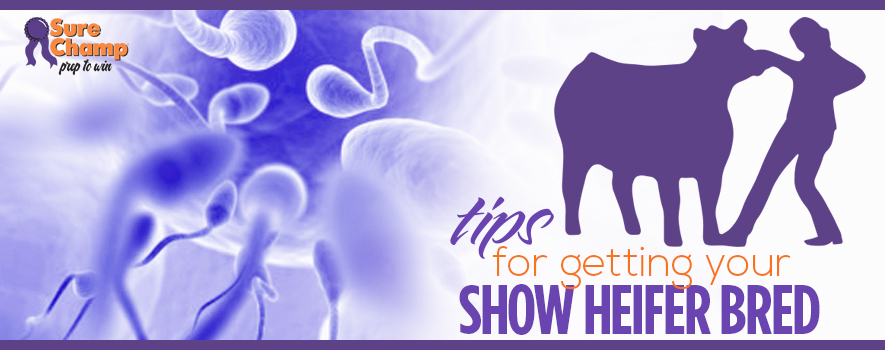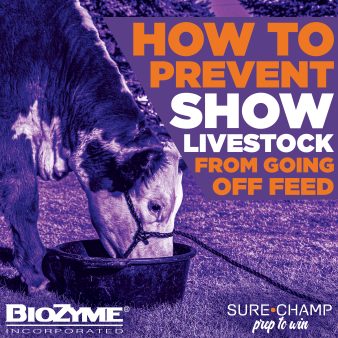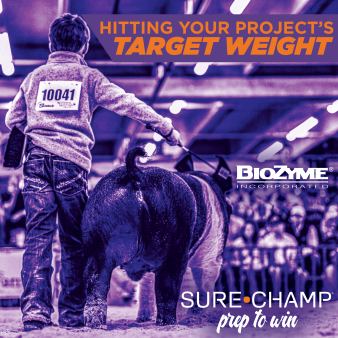
You’ve begged and pleaded with your parents. You’ve shown several market steers, and now you want a show heifer. She will be an investment, and you will have a foundation for your very own cow herd. But do you know the steps to transition her from pampered Pollyanna to a progressive, progeny producing female?
Kevin Glaubius, Director of Nutrition and Technical Sales for BioZyme® Inc., says to start early in the heat detection and breeding process to make sure you know the signs of heat and that your heifer is bred at an ideal weight and body condition.
“Start to observe your heifer and watch for her to come into heat when she is around 750 pounds,” Glaubius said. “When they do cycle that first time, log that date on a calendar, and watch to make sure she cycles again in three weeks.”
When your heifer stands to be mounted by another animal that is the most accurate sign of estrus. Standing heat is the most sexually intensive period of the estrous cycle. During this period, your heifer should stand to be mounted by another animal or move forward slightly with the weight of the mounting animal. If your heifer moves away quickly when a mount is attempted she is not in true estrus.
Glaubius said it is important to start the breeding process early in the heifer’s growth, while she weighs between 750-900 pounds. She should have a Body Condition Score (BCS) of 5.5 to 6. Remember, the gestation length is about 283 days or just slightly more than nine months, so take your ideal calving date into consideration while also getting your heifer bred while she is in her nutritional prime.
Twig Marston, Technical Sales Field Manager for BioZyme, stresses that it is important that your heifer calves by the time she is 24-months-old. He said that a 6 BCS is ideal for today’s show ring, and is close to ideal for breeding a first-calf heifer as well. Higher conditioned heifers with a BCS 7-8 will experience lower fertility, while heifers that are too thin will also be hard to breed, and have to be bred more often than what is idyllic.
An experienced A.I. technician should be able to get the heifer bred or “stuck” within two services. Remember, A.I. is not 100-percent successful and typically has a 60-percent success rate.
Nutritionally speaking, your heifer should be on a steady or increasing plane of nutrition prior to and during breeding season, Glaubius said. She is a growing animal, so her energy needs are still demanding.
Show heifers should be fed more moderate diets than a market steer; however, their mineral requirements are greater. Your heifer should be expected to gain 1.5 to 2.5 pounds per day.
“If your mineral system is part of your grain mixture, and heifers are fed less than steers, that can negatively affect their reproduction, as they are not getting all the trace minerals they need,” Glaubius said. “Her mineral requirements are elevated more than your steers’ that you are feeding for an end-point. You are building her to be in your herd for 12 years.”
Glaubius suggests using a full dose of Sure Champ® to top-dress your heifer’s feed. He also recommends offering VitaFerm® Concept•Aid® free-choice for show heifers to make sure they get their full mineral requirements, especially prior to breeding.
Once you have made sure your heifer’s nutritional needs have been met, you need to make sure you have found the right genetics to breed her to. Marston said the number one trait he would look for when selecting a bull to breed to a first-calf heifer is calving ease direct.
“There is enough data now in calving ease direct to make your job in sire selection easier,” he said. “Then look for other traits that will make your calves sellable, such as growth, carcass quality and structural conformation.”
If you have just one or two show heifers, and don’t have the need for a bull or have heifers of different breeds, A.I. is definitely the most efficient way to breed your heifers and allows you a wide variety of genetics to choose from. Marston said many local cattlemen can A.I. or your local semen representative might be able to suggest an A.I. technician in your area.
Both Marston and Glaubius agree there is value in having your heifer preg-checked. And once she is guaranteed safe, be sure to reduce the amount of stress you put on her for at least a week to let her embryo settle to her uterine wall.
To make sure your newly bred heifer’s stress is kept to a minimum for the first two weeks, be sure to keep her in a familiar environment and don’t comingle her with other animals or make any drastic changes in her diet for 7-10 days.
Another stress-reliever for your bred heifer is to keep her as cool as possible during the hot summer months of June, July and August. During those times, Glaubius suggests VitaFerm® HEAT™ mineral to help reduce stress, keep the heifers cool and keep their appetites healthy while growing your next potential show prospect.
Having a show heifer is a great experience. But the greater experience is making the nutritional and management decisions that will transition that heifer into a cow. This investment should pay dividends to you each year, with proper care and handling.

